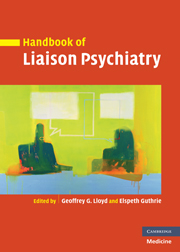Crossref Citations
This Book has been
cited by the following publications. This list is generated based on data provided by Crossref.
Carson, Alan
and
Stone, Jon
2012.
Current Themes in Psychiatry in Theory and Practice.
p.
101.
Bautovich, Alison
Katz, Ivor
Smith, Michelle
Loo, Colleen K
and
Harvey, Samuel B
2014.
Depression and chronic kidney disease: A review for clinicians.
Australian & New Zealand Journal of Psychiatry,
Vol. 48,
Issue. 6,
p.
530.
Levenson, James L.
and
Bledowski, Jozef L.
2015.
Psychiatry.
p.
2398.
Elyasi, Forouzan
Azizi, Marzieh
Sabourian Joubari , Sina
and
Mirani, Seyyed Hessam
2018.
Psychiatric Disorders Comorbidity in Two General Medical Hospitals in Iran Between 2014 - 2015.
Iranian Journal of Psychiatry and Behavioral Sciences,
Vol. In Press,
Issue. In Press,
Lobo, Antonio
Blanch, Jordi
Campos, Ricardo
Farré, Josep M.
Gómez-Reino, Ignacio
Lobo, Elena
Marco, Juan Carlos
Menchón, José Manuel
Navío, Mercedes
Parramón, Gemma
and
Ventura, Tirso
2019.
Global Psychosomatic Medicine and Consultation-Liaison Psychiatry.
p.
295.
van der Willik, Esmee M.
Meuleman, Yvette
Prantl, Karen
van Rijn, Giel
Bos, Willem Jan W.
van Ittersum, Frans J.
Bart, Hans A. J.
Hemmelder, Marc H.
and
Dekker, Friedo W.
2019.
Patient-reported outcome measures: selection of a valid questionnaire for routine symptom assessment in patients with advanced chronic kidney disease – a four-phase mixed methods study.
BMC Nephrology,
Vol. 20,
Issue. 1,



